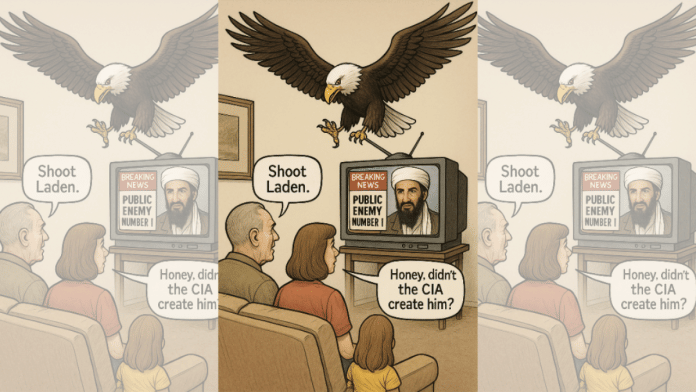Thank you dear subscribers, we are overwhelmed with your response.
Your Turn is a unique section from ThePrint featuring points of view from its subscribers. If you are a subscriber, have a point of view, please send it to us. If not, do subscribe here: https://theprint.in/
Teaser: As the Atharvaveda wisely observed, war begins in the minds of men. Propaganda, then, becomes the weapon to shape the minds of soldiers and civilians alike. But in the process, truth is the first to fall. Televised wars, in particular, offer a convenient mass distraction away from government failures. Yet over time, the same propaganda turns into a Frankenstein’s monster that destroys its creators.
War & Visuals: A Potent Blend
“If I’ve lost Cronkite, I’ve lost Middle America,” U.S. President Lyndon Johnson reportedly sighed.
It was February 1968. Walter Cronkite was just back from Vietnam. Dubbed “the most trusted man in America,” the CBS Evening News anchor broke ranks and described the Vietnam War as “mired in stalemate.” A stark contrast to the rosy official picture that had dominated airwaves till then.
Cronkite didn’t start the fire. But he did fan the smoke into national limelight. Just weeks earlier, the shock of the North Vietnamese Tet Offensive had shattered the illusion that America was winning. Soldiers were dying. Body bags were piling. Public patience was thinning.
What Cronkite did was blow the whistle over a simmering volcano of mass angst. The “first television war,” with its combat broadcasts from the harsh Vietnam jungles that had mesmerized Americans, now had them terrified.
President Johnson pulled out of the reelection race in March 1968.
The Good, the Bad & the Broadcasted
Fast forward five decades, and TV wars have only gotten slicker. And sinister.
Stung by Vietnam, the Pentagon tightly managed visuals during the First Gulf War (1991). CNN brought war into homes 24/7, showcasing smart bombs hitting targets with video-game precision. The American audience saw no gore, just fireworks and U.S. supremacy. They even named it “video game war.”

| Wikipedia
But Gulf War II (2003) was a messier sequel. Despite jaw-dropping live footage of Baghdad bombings, the heroic façade cracked as prolonged occupation, insurgencies, and the Abu Ghraib torture scandal made selective coverage untenable. Especially as they never found Saddam’s Weapons of Mass Destruction, supposedly deployable “within 45 minutes” – the excuse they’d used for going to war. Faith in leaders evaporated.
Nazi propagandist Joseph Goebbels would have been proud of the excuse though: “The bigger the lie, the more people believe it.”
Even righteous causes fracture under public scrutiny. The Afghan War to avenge 9/11 began with nationalist zeal. But televised funerals, civilian deaths, and America’s 2021 retreat—broadcast in real-time—ended it in disgrace. The imagery of desperate locals clinging to planes became a symbol of failed foreign policy.
The Afghans have a saying: “You may have the watch, but we have the time.” Like the Soviets and British earlier, the American watch ran out of Afghan occupation time.
Speaking of time, TV war coverage does sometimes push timely action. It was the real-time images of ethnic cleansing and refugee crisis in Bosnia and Kosovo forced NATO to act in the 1990s Yugoslavia conflict. Yet, critics decried one-sided narratives that simplified the complex and deep-rooted historical ethnic tensions.
That biased coverage is on full display in the ongoing-since-ages Israel-Palestine conflict. Rocket attacks from Gaza are branded “terror,” Israeli airstrikes termed “defence.” The other side asserts the opposite. Here, TV doesn’t just report. It defines heroes and villains. It crafts identities, stokes rage, and sways geopolitics.
In the meantime, an eye for an eye continues to make both sides blind.
But what when a section of TV media goes deliberately blind? India’s mainstream TV channels declared a 2025 post-Pahalgam victory so total, it sounded mythical – Indian forces destroying major Pakistani cities and military hubs. This, when the offensive was tactically focused on eliminating terror camps and military posts, not deep incursions.
What TV Wars Leave Behind
Done well, war coverage raises awareness. It humanizes the cost: lost generations, broken families, crippled cities, shattered homes, shell-shocked soldiers. It prompts dialogue. But selective visuals polarize. Worse, they glorify war, inspiring films and video games that recast horror as heroism. Blind patriotism truly is the virtue of the vicious!

The Vietnam War gave us gritty realism. Gulf War 1 gave us night-vision glory. Afghanistan gave us drone footage. Each one blurred lines between war and entertainment.
Next, TV wars shape politics, drumming up support for invasions, sanctions, suppression of dissent, and defence budget escalations. Remember U.S. President Eisenhower’s 1961 farewell address that warned against the growing influence of the military-industrial complex?
But eventually, the narrative slips. From Vietnam to Iraq to Afghanistan, it always has. What begins as patriotism often ends in protest, policy collapse, and leadership exits. Because real patriots – they may not always wear uniforms – finally stand up to defend their country against its government.
Finally . . . the Whole Truth
More than half a century after Cronkite’s fateful words, war still gets televised. And so do blatant lies, half-truths, and doctored visuals. In an age of deepfakes, misinformation, and algorithm-driven outrage, old lessons stand tall:
Seeing is not always believing.
And believing too soon can cost everything.
These pieces are being published as they have been received – they have not been edited/fact-checked by ThePrint.


